- Faculty News
- Student News
- Lab News
- Publications
- Meetings and Presentations
- Outreach
- Grants
- Announcements
- About This Newsletter
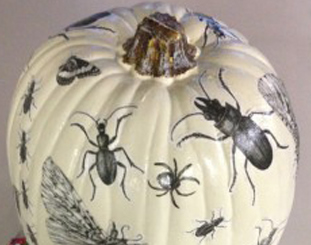
ABOVE: It is that time of year again, when Treater trickmaxamis (commonly known as trick-or-treaters) will be on the move again. Learn more about these organisms and their complex communication and social structure.
On October 3rd Dr. Christine W. Miller presented an invited seminar titled "Sexual selection in complex environments" as part of the Ecology and Evolution Seminar Series at Florida State University.

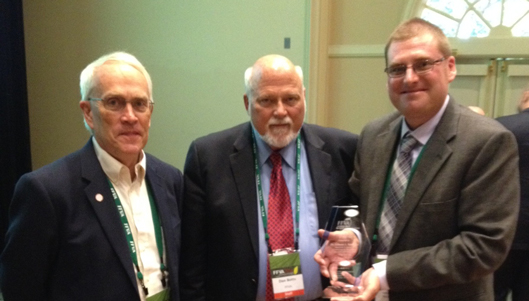
ABOVE: Dr. Lukasz L. Stelinski was awarded the 2014 Researcher of the Year Award from the Florida Fruit and Vegetable Association. Pictured here Dan Botts (Vice President of the FFVA), Rick Kress (President of Southern Gardens) and Dr. Stelinski. You can read more about the award in this article by the Southeast Farm Press.
ENSO News
The Entomology & Nematology Student Association (ENSO) website (http://entomology.ifas.ufl.edu/enso/) received a face-lift. Any comments, critiques, or suggestions are welcome to improve the website. Please contact either Christoper Crockett or Oliver Keller.
 Graduate Student News
Graduate Student News
We would like you to meet one of the students in our distance Master's program Marian Lyman Kirst. She grew up in Montana, where she developed a fascination with insects and arachnids. She attended college in New York for environmental science and then went to Boston University for a Master's degree in science journalism. A chance viewing of David Attenborough's "Life in the Undergrowth" convinced her to pursue invertebrate conservation work.

ABOVE: A snakefly collected by Marian Lyman Kirst in Carbon County, MT, near Red Lodge. Marian is based out of Billings, MT and is an enthusiastic macro-invertebrate photographer. This summer she took some white-box shots of a couple of the insects she found while working on Dr. Baldwin's insect collection assignment. See more of her work on Tumblr.

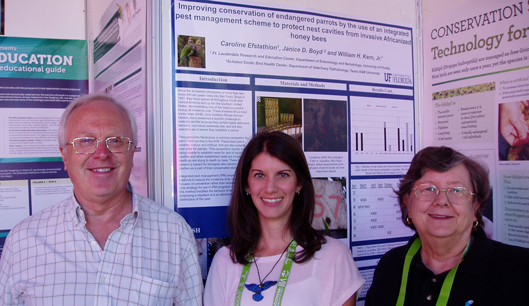
ABOVE: The Director of Loro Parque, Dr. Davie Waugh, Caroline Efstathion (Dr. Bill Kern’s Ph.D. student) and Dr. Janice Boyd from Texas A&M standing in front of Caroline's poster entitled "Improving conservation of endangered parrots by the use of an integrated pest management scheme to protect nest cavities form invasive Africanized honey bees" at the VIII International Parrot Convention in Tenerife, Spain, September 22-25th.
 Ms. Rachel Watson, an undergraduate student majoring in chemistry, joined the laboratory of Dr. James P. Cuda as a volunteer on September 15th. Ms. Watson is helping with host range testing of the weevil, Apocnemidophorus pipitzi, a stem boring natural enemy of Brazilian peppertree.
Ms. Rachel Watson, an undergraduate student majoring in chemistry, joined the laboratory of Dr. James P. Cuda as a volunteer on September 15th. Ms. Watson is helping with host range testing of the weevil, Apocnemidophorus pipitzi, a stem boring natural enemy of Brazilian peppertree.
Need to name that bug? A host of experts are available to help Floridians identify any insect or related arthropod. If a mystery creature has six or more legs, the UF Insect ID Lab is the place to call.
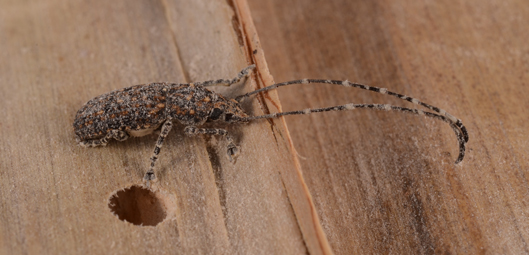
ABOVE: Family Anthribidae, the fungus weevils. Remember that one from your entomology classes? It is not a group that we think about often, but some owners of tiki huts in central and south Florida sure are thinking badly of them. The species of concern is Phoenicobiella chamaeropis. It is a native species associated with cabbage palms. The weevil larvae bore in the stems of the dead leaves. They become a problem when they attack palm leaves that been used to make thatch roofs of tiki huts. People below are disturbed to see fine dust raining down into their drinks. These “tiki weevils” are about a half-inch long, and males have antennae that are nearly twice as long as the body.
Lyle Buss is the Insect ID Lab manager.
 Think it might be a nematode problem? The Nematode Assay Laboratory serves Florida and other states by providing nematode assays and expert advice regarding nematode management.
Think it might be a nematode problem? The Nematode Assay Laboratory serves Florida and other states by providing nematode assays and expert advice regarding nematode management.
For more information on the Nematode Assay Laboratory please contact the lab manager, Dr. Tesfa Mengistu.
Baniszewski J, Coon BR, Cuda JP, Harms NE, Grodowitz MJ, Habeck DH, Hill JE, Russell J, Weeks ENI. 2014. Insects and fish associated with hydrilla, pp. 77-124. In: JL Gillett-Kaufman, V Ulrike- Lietze, ENI Weeks, Hydrilla Integrated Management. UF/FAS. Gainesville, FL.
Coon BR, Harms NE, Cuda JP, Grodowitz MJ. 2014. Laboratory biology and field population dynamics of Trichopria columbiana (Hymenoptera: Diapriidae), an acquired parasitoid of two hydrilla biological control agents. Biocontrol Science and Technology 24: 1243-1264.
Cooper TM, Frank JH. 2014. Description of the larval instars of Lixadmontia franki (Diptera: Tachinidae). Florida Entomologist. 97: 1002-1014.
Cuda, JP. 2014. Chapter 5: Aquatic plants, mosquitoes and public health, pp. 31-36. In: Gettys LA, Haller WT Petty DG (eds.), Biology and Control of Aquatic Plants: A Best Management Practices Handbook, 3rd edition. Aquatic Ecosystem Restoration Foundation, Marietta, GA.
Cuda, JP. 2014. Chapter 8: Introduction to biological control of aquatic weeds, pp. 51-58. In: Gettys LA, Haller WT, Petty DG (eds.), Biology and Control of Aquatic Plants: A Best Management Practices Handbook, 3rd edition. Aquatic Ecosystem Restoration Foundation, Marietta, GA.
Cuda, JP. 2014. Chapter 9: Insects for biocontrol of aquatic weeds, pp. 59-66. In: Gettys LA, Haller WT, Petty DG. (eds.), Biology and Control of Aquatic Plants: A Best Management Practices Handbook, 3rd edition. Aquatic Ecosystem Restoration Foundation, Marietta, GA.
Dababat A, Imren, M, Erginbas-Orakci G, Ashrafi S, Yavuzaslanoglu Y, Toktay H, Pariyar S, Elekcioglu H, Morgounov A, Mekete T. 2014. The importance and management strategies of cereal cyst nematodes, Heterodera spp., in Turkey. Euphytica. DOI 10.1007/s10681-014-1269-z
Frank JH, Kelly SL, Almquist DA. 2014. Notes on Diochus Erichson, Lissohypnus Casey, and Oxybleptes Smetana (Coleoptera: Staphylinidae) in Florida, including a description of a new species of Lissohypnus.Insecta Mundi. 0382: 1-8.
Martini X, Kuhns EH, Hoyte A, Stelinski LL. 2014. Plant volatiles and density-dependent conspecific odors are used by Asian citrus psyllid to evaluate host suitability on a spatial scale. Arthropod-Plant Interactions. 8: 453-460.
Matos-Maraví P, Águila RN, Peña C, Miller JY, Sourakov A, Wahlberg N. 2014. Causes of endemic radiation in the Caribbean: Evidence from the historical biogeography and diversification of the butterfly genus Calisto (Nymphalidae: Satyrinae: Satyrini). BMC Evolutionary Biology 14(1): 199.
McTaggart AL, Eberl T, Keller O, Jameson ML. 2014. First report of Batrachochytrium dendrobatidis associated with amphibians in Kansas. Herpetological Review. 45(3): 439-441.
Ray HA, Hoy MA. 2014. Effects of reduced-risk insecticides on three orchid pests and two predacious natural enemies. Florida Entomologist. 97(3): 972-978.
 New on Featured Creatures:
New on Featured Creatures:
Imperial moth, Eacles imperialis imperialis (Drury, 1773). Author: Donald W. Hall, Entomology and Nematology Department, University of Florida
African malaria mosquito, Anopheles gambiae Giles. Authors: Sabrina A. White and Phillip E. Kaufman, Entomology and Nematology Department, University of Florida
Pavement ant, Tetramorium caespitum (Linnaeus). Authors: Tyler Vitone and Andrea Lucky, Entomology and Nematology Department, University of Florida
Do you have a favorite creature? Learn how to make it into a Featured Creature!
Dr. James P. Cuda was a co-author on a poster presentation titled, "Impacto de Calophya latiforceps Burckhardt (Hemiptera: Calophyidae) no crescimento de Schinus terebinthifolia na Flórida, EUA." The poster was presented at the XXV Congresso Brasileiro de Entomologia, Goliâna, Brazil, 14-18 September.
Dr. James P. Cuda was a co-author on a presentation titled, "Evaluation of Methionine as a Larvicide and its Potential for Use in Mosquito IPM." The presentation, which also was co-authored by Dr. Emma Weeks, was included in the program at the 2014 IR-4 Food Use & Biopesticide Workshop held in Atlanta, GA, 9-10 September.
Dr. James P. Cuda was an invited speaker for the Annual Meeting of the Aquatic Vegetation Control Group held in Palm Beach Gardens, FL. Cuda gave a presentation titled "Invasive Plant Management- the other IPM."
Dr. James P. Cuda was an invited speaker for a LAKEWATCH event held in Odessa, FL, 2 October. Cuda gave a presentation titled "Hydrilla IPM" that was co-authored by Drs. Jennifer Gillett-Kaufman, Raymond Hix, Verena-Ulrike Lietze and Emma Weeks.
 Dr. Susan Halbert presented a seminar for the UF Plant Pathology Department on September 23rd. The title was "Surprising results and implications of the Florida Asian citrus psyllid testing project." Coauthors were Manjunath Keremane, USDA/ARS/NCGRCD; Chandrika Ramadugu, U CA, Riverside; Richard Lee, USDA/ARS/NCGRCD; Jo Ann Lee, UF Mathematics Department; James Keesling, UF Mathematics Department; Burt Singer, Emerging Pathogens Institute, UF; and William O. Dawson, UF CREC.
Dr. Susan Halbert presented a seminar for the UF Plant Pathology Department on September 23rd. The title was "Surprising results and implications of the Florida Asian citrus psyllid testing project." Coauthors were Manjunath Keremane, USDA/ARS/NCGRCD; Chandrika Ramadugu, U CA, Riverside; Richard Lee, USDA/ARS/NCGRCD; Jo Ann Lee, UF Mathematics Department; James Keesling, UF Mathematics Department; Burt Singer, Emerging Pathogens Institute, UF; and William O. Dawson, UF CREC.
 A combined meeting of the Southern Lepidopterists’ Society and the Association for Tropical Lepidoptera was held from September 26th to the 28th at the McGuire Center for Lepidoptera and Biodiversity.
A combined meeting of the Southern Lepidopterists’ Society and the Association for Tropical Lepidoptera was held from September 26th to the 28th at the McGuire Center for Lepidoptera and Biodiversity.
Presentations by students and staff affiliated with the Department were as follows:
- Maria F. Checa- Butterfly farming: A successful approach to achieve conservation and development in western Ecuador.
- Jaret Daniels and Marc Minno- Update on the status and conservation of Heraclides aristodemus ponceanus in south Florida.
- Nicholas Homziak- Next-generation sequencing to help resolve relationships in the Erebinae (Lepidoptera: Erebidae).
- Pablo Sebastián Padrón- Preliminary molecular phylogeny of the genus Catasticta.
- Keith Willmott- The role of the Andes in the diversification of Neotropical butterflies: Vicariance or dispersal?
- Jade Aster Badon- Butterflies of the Philippines: The conservation and preservation of habitats from anthropogenic factors.
- Andrei Sourakov- Two heads are better than one: How hairstreaks escape attacks by jumping spiders.
- Delano S. Lewis and Shinichi Nakahara- Papilio (Heraclides) hyppason Cramer, 1775 (Lepidoptera: Papilionidae): Systematic placement and record from the Orinoco Delta.
From the Outreach Coordinator
The live critters are always a hit with children and adults alike. The critters are available for you to check out should you be leading an outreach event. We have doubles of our most popular critters, as well as various native insect species depending on the time of year. We have large wood and Plexiglas cages for viewing our native orb weaving spiders. There is one travel cage and one larger static cage. Please be sure to contact us and review the protocol on transporting and handling the critters if you are not already familiar with the process. If you lead an outreach, be sure to fill out a documentation form so your event can be included in the newsletter and we can log all outreach events.
If you would like to schedule an event or have any outreach questions, go to the Outreach pages on our Bug Club Website and contact us.
 Getting social!
Getting social!
We have several social media sites for the UF Entomology and Nematology Department. To make them easily searchable, all three (YouTube, Facebook, and Twitter) have the same page name: UFEntomology. Please share these links with past students or colleagues who may have an interest in departmental activities.
Virni Mattson, our grants specialist, reports that from September 1st to September 30th our external funding for all UF Entomology and Nematology faculty (in Gainesville and at RECs) was $553,646.22. This was for 14 new awards or contracts.
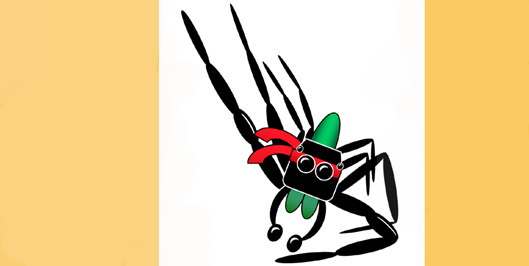
ABOVE: Dr. Lisa Taylor’s lab is expanding their spider research fundraising site where they create and sell spider themed gear to support their research program. If you want to support their cause, need a spider t-shirt in time for Halloween, or if you are an artist or art student who is interested in contributing a design, visit www.spiderpalooza.org.
We like to share news when it happens using our social media outlets: Twitter, Facebook, and YouTube. Follow us on these sites for daily updates! When you send news, we will post it on one or more of these sites and again in the monthly newsletter. Please be sure you have permission from people in photographs you submit for publication.
UF-Bugnews-L listserv subscribers receive notices when issues are posted. Our home page has instructions for subscribing and unsubscribing.
Special thanks to Haleigh Ray and Nancy Sanders, who reviewed the newsletter for errors, and to Jane Medley and Don Wasik, who built the web page design.